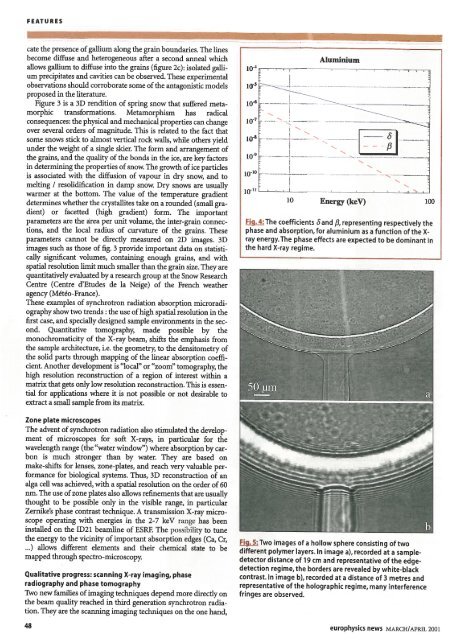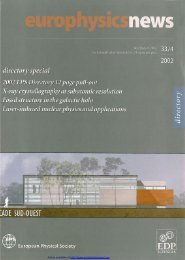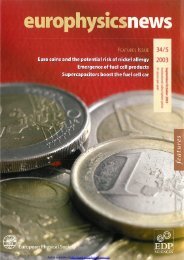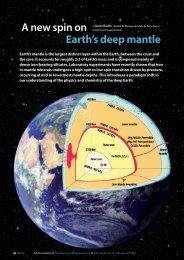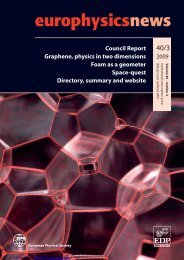Whole issue in PDF - Europhysics News
Whole issue in PDF - Europhysics News
Whole issue in PDF - Europhysics News
Create successful ePaper yourself
Turn your PDF publications into a flip-book with our unique Google optimized e-Paper software.
FEATURES<br />
cate the presence ofgallium along the gra<strong>in</strong> boundaries. The l<strong>in</strong>es<br />
become diffuse and heterogeneous after a second anneal which<br />
allows gallium to diffuse <strong>in</strong>to the gra<strong>in</strong>s (figure 2c): isolated gallium<br />
precipitates and cavities can be observed. These experimental<br />
observations should corroborate some ofthe antagonistic models<br />
proposed <strong>in</strong> the literature.<br />
Figure 3 is a 3D rendition of spr<strong>in</strong>g snow that suffered metamorphic<br />
transformations. Metamorphism has radical<br />
consequences: the physical and mechanical properties can change<br />
over several orders of magnitude. This is related to the fact that<br />
some snows stick to almost vertical rock walls, while others yield<br />
under the weight of a s<strong>in</strong>gle skier. The form and arrangement of<br />
the gra<strong>in</strong>s, and the quality ofthe bonds <strong>in</strong> the ice, are key factors<br />
<strong>in</strong> determ<strong>in</strong><strong>in</strong>g the properties ofsnow. The growth ofice particles<br />
is associated with the diffusion of vapour <strong>in</strong> dry snow, and to<br />
melt<strong>in</strong>g I resolidification <strong>in</strong> damp snow. Dry snows are usually<br />
warmer at the bottom. The value of the temperature gradient<br />
determ<strong>in</strong>es whether the crystallites take on a rounded (small gradient)<br />
or facetted (high gradient) form. The important<br />
parameters are the area per unit volume, the <strong>in</strong>ter-gra<strong>in</strong> connections,<br />
and the local radius of curvature of the gra<strong>in</strong>s. These<br />
parameters cannot be directly measured on 2D images. 3D<br />
images such as those of fig. 3 provide important data on statistically<br />
significant volumes, conta<strong>in</strong><strong>in</strong>g enough gra<strong>in</strong>s, and with<br />
spatial resolution limit much smaller than the gra<strong>in</strong> size. They are<br />
quantitatively evaluated by a research group at the Snow Research<br />
Centre (Centre d'Etudes de la Neige) of the French weather<br />
agency (Meteo-France).<br />
These examples of synchrotron radiation absorption microradiography<br />
show two trends: the use ofhigh spatial resolution <strong>in</strong> the<br />
first case, and specially designed sample environments <strong>in</strong> the second.<br />
Quantitative tomography, made possible by the<br />
monochromaticity of the X-ray beam, shifts the emphasis from<br />
the sample architecture, i.e. the geometry, to the densitometry of<br />
the solid parts through mapp<strong>in</strong>g of the l<strong>in</strong>ear absorption coefficient.<br />
Another development is ''local'' or"zoom" tomography, the<br />
high resolution reconstruction of a region of <strong>in</strong>terest with<strong>in</strong> a<br />
matrix that gets onlylow resolution reconstruction. This is essential<br />
for applications where it is not possible or not desirable to<br />
extract a small sample from its matrix.<br />
Zone plate microscopes<br />
The advent ofsynchrotron radiation also stimulated the development<br />
of microscopes for soft X-rays, <strong>in</strong> particular for the<br />
wavelength range (the"water w<strong>in</strong>dow") where absorption bycarbon<br />
is much stronger than by water. They are based on<br />
make-shifts for lenses, zone-plates, and reach very valuable performance<br />
for biological systems. Thus, 3D reconstruction of an<br />
alga cell was achieved, with a spatial resolution on the order of60<br />
nm. The use ofzone plates also allows ref<strong>in</strong>ements that are usually<br />
thought to be possible only <strong>in</strong> the visible range, <strong>in</strong> particular<br />
Zernike's phase contrast technique. A transmission X-ray microscope<br />
operat<strong>in</strong>g with energies <strong>in</strong> the 2-7 keY range has been<br />
<strong>in</strong>stalled on the ID21 beaml<strong>in</strong>e of ESRF. The possibility to tune<br />
the energy to the vic<strong>in</strong>ity ofimportant absorption edges (Ca, Cr,<br />
...) allows different elements and their chemical state to be<br />
mapped through spectro-rnicroscopy.<br />
Qualitative progress: scann<strong>in</strong>g X-ray imag<strong>in</strong>g, phase<br />
radiography and phase tomography<br />
Two new families ofimag<strong>in</strong>g techniques depend more directly on<br />
the beam quality reached <strong>in</strong> third generation synchrotron radiation.<br />
Th~y are the scann<strong>in</strong>g imag<strong>in</strong>g techniques on the one hand,<br />
48<br />
Alum<strong>in</strong>ium<br />
Energy (keY)<br />
100<br />
Fig. 4: The coefficients 8 and [3. represent<strong>in</strong>g respectively the<br />
phase and absorption, for alum<strong>in</strong>ium as a function of the X<br />
ray energy.The phase effects are expected to be dom<strong>in</strong>ant <strong>in</strong><br />
the hard X-ray regime.<br />
Fig. 5: Two images of a hollow sphere consist<strong>in</strong>g of two<br />
different polymer layers. In image a), recorded at a sampledetector<br />
distance of 19 cm and representative of the edgedetection<br />
regime, the borders are revealed by white-black<br />
contrast. In image b), recorded at a distance of 3 metres and<br />
representative ofthe holographic regime, many <strong>in</strong>terference<br />
fr<strong>in</strong>ges are observed.<br />
europhysics news MARCH/APRIL 2001


